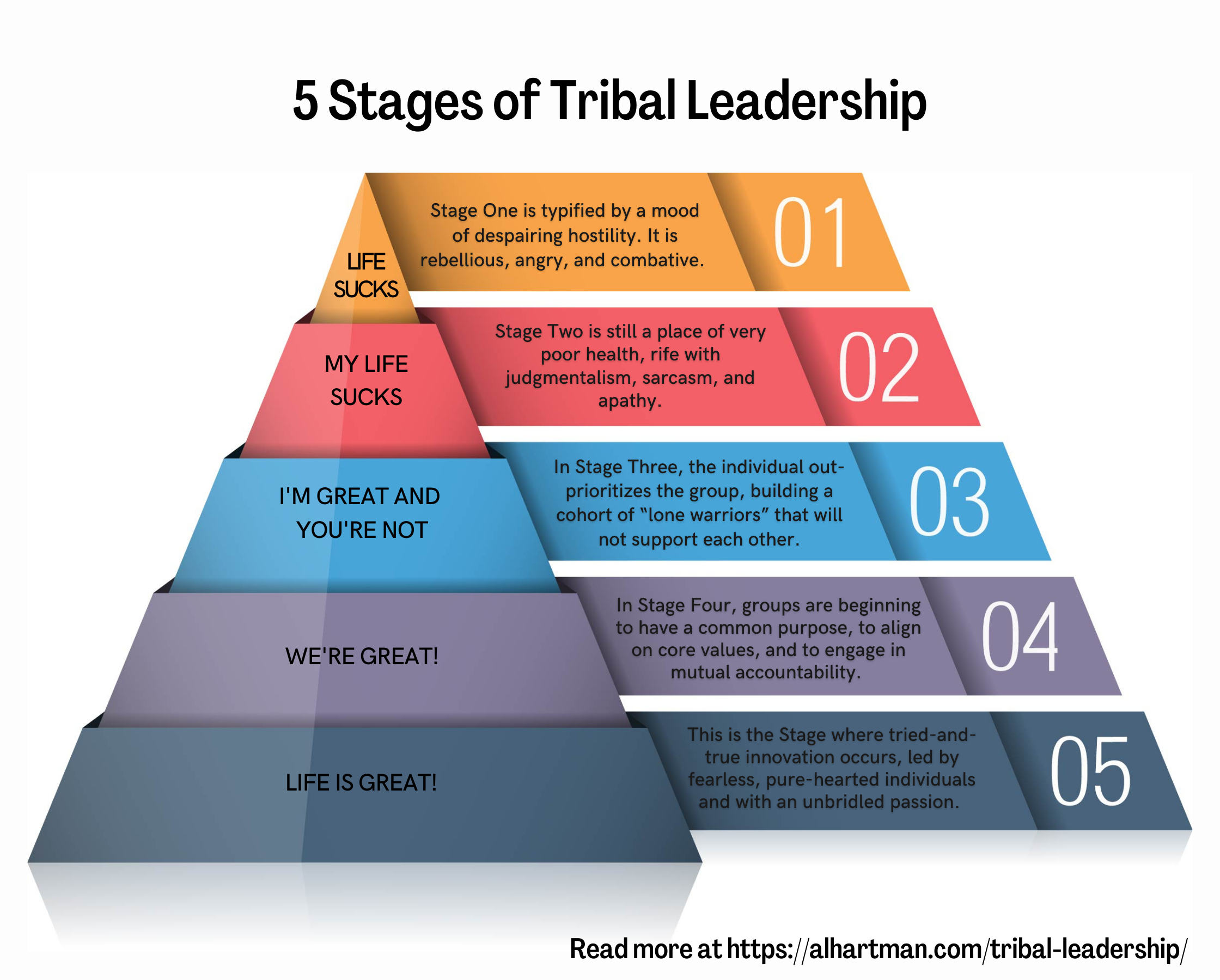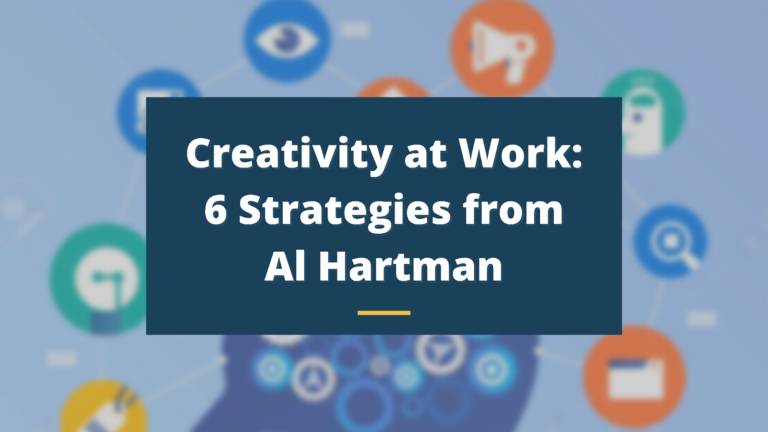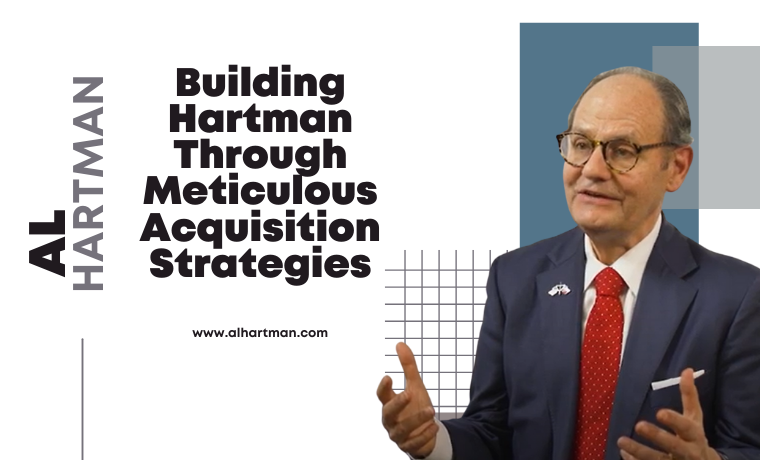Last year, I read the book Tribal Leadership by Dave Logan, John King, and Halee Fischer-Wright. I was moved by the critical lessons about improving business performance through an organization’s culture.
The book presented a unique perspective on how leaders can leverage the natural occurring groups, or “tribes,” in an organization to set a clear path for achieving shared goals. A big idea is that human tribes can be guided to “progressively upgrade any organizational culture” in five stages. That idea intrigued me, and there is reliable research to back up the authors’ conclusions.

The research team — led by Logan, King, and Fischer-Wright — spent 10 years of field study, observing about 24,000 people in 24 global companies. Their findings show that effectiveness, engagement, job satisfaction, and an expectation for future success were all positively impacted by strong tribal leadership.
The book sets forth a wide variety of valuable principles, explaining that the positive outcomes of leadership like this aren’t just revenue or success goals, but making a real difference in the lives of employees, our communities, and ultimately the world.
This message resonated deeply with me, as it echoed something that we at Hartman have sought to emulate for years. I wanted to provide a summary of that piece and cast a vision before you of how I see our own company growing toward unity of thought and purpose.

What is a Tribe?
 | “Tribes are the natural way we live and organize ourselves.” |
Every organization is itself a tribe which can contain other tribes. Tribes are groups of 20-150 people. As a company grows, and more employees join, tribes will naturally form.
A tribe’s effectiveness is determined by its culture. There are various cultural stages a tribe can move through, which lead to higher realms of measurable effectiveness. Every tribe has a dominant culture, which is classified into five stages.
What Tribal Stage Are You in?
 | “Culture determines effectiveness.” |
These are the five tribal stages:
Stage One — “Life sucks.” Stage One is typified by a mood of despairing hostility. It is rebellious, angry, and combative. Thankfully, very few companies operate for long at this very low-level stage.
Signs of Stage One: alienation, isolated gangs that operate by their own rules, even acts of violence or verbal abuse can be expected.
Stage Two — “My life sucks.” 25% of workplace tribes have Stage Two as their defined, dominant culture. While it is an improvement on the dog-eat-dog mentalities of Stage One, it is still a place of very poor health, rife with judgmentalism, sarcasm, and apathy.
Signs of Stage Two: Disconnectedness, apathy, doing the bare minimum, taking no initiative, passive-aggressive behavior, unmet needs, disappointment, repressed anger.

Stage Three — “I’m great and you’re not.” 49% of workplace tribes in the U.S. live here. “I’m great,” at the face of it, seems high-functioning. But there is an implicit, “and you’re not” in this Stage that uncovers its seedy underbelly: the individual out-prioritizes the group, building a cohort of “lone warriors” that do not/will not help or support each other.
Signs of Stage Three: People engage, but are mostly in it for themselves and will misrepresent themselves in an effort to appear smarter and better than other people. There is minimal personal sharing and winning (a personal endeavor) is all that matters.
Stage Four — “We’re great.” 22% of workplace tribal cultures are in Stage Four, and it is a major improvement over the first three stages. Groups are beginning to have a common purpose, to align on core values, and to engage in mutual accountability. There can be some challenge of stability at this level, with many organizations vacillating between Stages Three and Four on a regular basis.
Signs of Stage Four: Teams are focused, have shared values, and a common purpose. They do the right thing and solve problems on their own. A warning for leaders is that high levels of stress will lead to a backslide to Stage Three.
Stage Five — “Life is great.” Less than 2% of U.S. workplaces have arrived at this comparative utopia of teamsmanship, outstanding communication, groundbreaking efforts, and shared drive toward global impact. This is the Stage where tried-and-true innovation occurs, led by fearless, pure-hearted individuals and with an unbridled passion.
Signs of Stage Five: Tribes don’t focus on what the competition is doing: they are the biggest fans of their own culture and celebrate their own efforts. Everyone works well together and there is very little fear, stress, or conflict. Every day, leaps are happening to propel the company forward.
Tribes are the most powerful vehicles within a company, and culture is the engine that drives them forward.
The Tribal Leadership Process
 | “[Tribal leaders] attract and unify people by getting them to discuss what they really care about, and rallying them around common causes.” |
 Tribes and leaders create each other in an ever-evolving cycle. Whether you are a tribal member or a tribal leader: which stage do you see your company in? Consider the distinguishing factors above. It’s essential that you’re honest with your current state if you ever hope to upgrade beyond it.
Tribes and leaders create each other in an ever-evolving cycle. Whether you are a tribal member or a tribal leader: which stage do you see your company in? Consider the distinguishing factors above. It’s essential that you’re honest with your current state if you ever hope to upgrade beyond it.
Any change that can occur among tribes will be based on leverage points, which include the two observable factors (language and behavior) and a number of intangible factors. Leaders themselves must be personally upgraded to Stage Four if they hope to lead their team forward.
Great leaders will thoughtfully and intentionally usher people through the various stages of tribal leadership to reach a point of stability at which optimal operation and organizational maturity can be achieved.
Over the last year, I’ve personally placed a key focus on identifying our company’s tribal level, and prioritized an upgrade for the Hartman tribes. I followed the book’s recommendations, making a concerted effort to change the language and behavior in our company.
Here are two examples:
The Hartman Hiring Process
 I have built the company on strong biblical principles. It’s important that all new team members understand the importance of personal values and shared values company-wide. As tribes, we find common ground, seek out like-minded individuals, and work hard to live in a climate of kindred spirits and understanding.
I have built the company on strong biblical principles. It’s important that all new team members understand the importance of personal values and shared values company-wide. As tribes, we find common ground, seek out like-minded individuals, and work hard to live in a climate of kindred spirits and understanding.
DARTS
Another way we’ve worked on our tribes is to connect internal language to meaningful action. Each quarter, all departments establish DARTS. Each department gathers together to brainstorm on how to solve problems within the department. Employees are then held accountable and assigned specific tasks from the brainstorming, reporting weekly to their teams on progress made throughout the quarter.
This is just one way we see steady improvement toward feeling like we’re sharing the wins, saying with confidence, “we are great.”
You may be thinking, “it’s great that you upgraded the tribes like that, but the ‘how’ for my team is the bigger issue.” That’s true. This tribal leadership framework is a great idea, but the tactics of managing culture change are complex.
Allow me to shed some light on how we’ve created our own roadmap for success:
Values and a Noble Cause
Everything we do at Hartman is a rally around our stated values. Every single employee signs off on these, and we tie everything we do back to them, from our hiring and onboarding to our Exceptional White Glove Service training to our accountability to our celebrations.
Outcomes: What We Want
For years, we have wanted to be a “breakthrough company.” I had absolute clarity on my vision for how we would function and how we would serve customers. This servant leadership approach is something myself and my executive team have stuck to without wavering. It is something that continues to provide a North Star of direction for every decision we make. We know what we want and what we want to be.
Assets: What We Have
The growth and development of our people is the highest calling of leadership. Put simply, we evaluate the effectiveness of our leadership based on how we develop our primary appreciable asset: our people. We steward what we have done well, and it shapes our culture.
Behaviors: What We Will Do
Strong ethics are a key part of the success formula for top leaders. We control our destiny. The structure and discipline we all bring to our conduct directly impacts our performance. Great leaders live by a code, which not only safeguards decision-making but embeds predictability in how they will act. Tactics change, but our beliefs stay the same, and we will always do the right thing.
Implementing the Tribal Strategy
Ultimately, guiding tribes into Stage 5 is an exercise in consistency: when you are driven by just cause, know what you want, care for what you have, and make value-based decisions, you will witness a series of defining moments in which a tribe moves from “I’m great” to “we are great” to “life is great.” It starts at the top.

How to Scale a Tribe to Level 5
Stage 5 is where we all want to be. Tribe leaders are enthusiastic and impassioned. Tribal members are motivated, productive, and free to exercise creativity at work. It’s a place of true delight; a place where anything can happen.
I’ve offered many suggested approaches and illustrations of how we are on our journey toward Stage 5. Let me leave you with some important reminders:
- Every company is on a journey, and your status in a tribal Stage is not fixed. You can move any direction, so it is vital that leaders are continuously motivated to analyze and enact fresh strategies for encouraging their tribes.
- Moving through the Stages is progressive. Be honest with yourself about where your team currently is, recognizing that you have every ability to move progressively into new Stages. It won’t happen overnight, so be patient, but intentional.
- The ultimate goal to reach Stage 5 is far more than business success: it is about changing the world. If you think your vision is big enough: think again. A tribe that is at Stage 5 is capable of anything, so buckle up. You may be on the cusp of achieving more than you’d ever dreamed.
We Play to Win
In my book, The Power of Proven Results, I wrote the following:
 | “We have a simple philosophy: if we all work together and share the same vision, mission, and purpose, we can accomplish anything. We take great care in crafting who we are and what we believe so we reach the goals of our firm, team members, and investors.” |
What I describe is an acknowledgement that we are tribes, moving with intention — “upgrading,” if you will — into places of greater stability and effectiveness. As we progress through these stages with intention, we have every chance in the world of providing exceptional services based on our inspired values. It’s what has differentiated us from the very beginning, and what will continue to define us as we grow, forming new tribes, but never departing from our shared vision for excellence.
Learn more about Achieving Excellence in the Workplace: Building Your Organization’s Leadership





